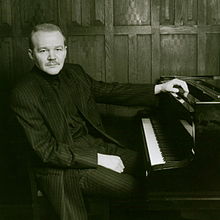László Simon
László Simon (born July 16, 1948 in Miskolc ; † September 9, 2009 in Berlin ) was a Hungarian pianist .
Vita
László Simon studied with Zoltán Benkö in Budapest and with Hans Leygraf in Stockholm and Hanover. He received artistic and pianistic suggestions from Claudio Arrau in New York. He was awarded prizes at the international piano competitions Casagrande (1971, 1st prize ex-aequo), Geneva and Busoni (1975, 3rd prize ex-aequo), and the Royal Swedish Music Prize. His recording of the twelve Études d'exécution transcendante by Franz Liszt was plagiarized in 2007 in the scandal surrounding the English pianist Joyce Hatto (1928–2006) and gained additional fame when the fraud was discovered.
László Simon was a world-renowned piano teacher. After working in Darmstadt, Hanover and Karlsruhe, he took over a professorship at the Berlin University of the Arts in 1981 . Among his students were the future conductor Shi-yeon Sung and the pianists Gergely Boganyi , Li-Chun Su and Ji-yeoun You .
Press
Tibor Kneif: Struggle for every attack . In: Der Tagesspiegel (3rd Dec 1982)
“In the possession of a comparable, immaculately developed technique, another pianist would perhaps be tempted to show off his manual superiority in the performance of a well-trained memory. Like Franz Liszt himself, however, he would savor the hymn-like floating chords at the end of the cyclical B minor sonata with an urbane sidelong glance at the spellbound listener. The Swedish piano virtuoso László Simon, born in Hungary in 1948, makes no sense for such theatrical effects. "
“He doesn't present tone sequences that have been practiced a hundred times with the comforting feeling that nothing could actually go wrong; rather, on the podium of the music hall, he seems to be fighting against a lurking amnesia and reminding himself of every note. His suffering, sometimes contorted face while playing arouses the feeling that tones are not his confidants, but his adversaries, whom he has to overcome with relentless vigilance. László Simon has no time to stare at his audience when he is fighting against the inertia of the subject. "
“Like every significant interpretation, the pianistic performance of the Arrau student Laszlo Simon is based on the simultaneity of two poles, a glowing, fantastic obsession and a merciless art-critical sobriety. In the midst of this bi-polarity, Schubert's rondo-like Three Piano Pieces (D946) were created - an overly simple title in view of their wealth of ideas as well as their heavenly or at least half-hour length - the singing right hand was guided by her while the left hand was muted. "
“I already spoke of manual skill above: One would have to report on the artful use of the pedals, for which apparently no nuance is unknown, no combining reverberation of separate chords seems impossible. Simon's interest is everywhere in the structures of a work in the micro range and as a whole, in Liszt's sonata no less than in Kodály's "Méditation sur un motiv de Claude Debussy" and the fifth of the 7 piano pieces op. 11. By the way, both of the latter works are Kodály's here So completely unknown to the audience that the applause only occurred to him when the dances from Maroszék began with their strange mixture of simple folklore and impressionistic fourth-low chords. With three short encores, including two titles from Bartók's For Children , the soloist thanked him for the sustained applause. In October 1981 László Simon was appointed professor at the HdK. Belated, emphatic congratulations from Tibor Kneif on this decision. "
Hellmut Kotschenreuther: The Unknown Liszt In: Der Tagesspiegel (Nov. 1983)
“Laszlo Simon burrowed his way into their darkness with never-ending intensity, an interpretation of incontestable validity. (...) the work of etudes is a challenge in every edition, which only a pianist with above-average manual aptitude and an innate virtuoso talent can reasonably overcome. László Simon is such a pianist. "
Web links
- CD collection László Simon IN MEMORIAM
- Recordings of Laszlo Simon at BIS
- Press article about the plagiarism on behalf of Joyce Hatto
Individual evidence
- ^ Neue Zürcher Zeitung: A fraud of rare audacity March 4, 2007, accessed on March 29, 2019
| personal data | |
|---|---|
| SURNAME | Simon, László |
| BRIEF DESCRIPTION | Hungarian pianist |
| DATE OF BIRTH | July 16, 1948 |
| PLACE OF BIRTH | Miskolc |
| DATE OF DEATH | September 9, 2009 |
| Place of death | Berlin |
